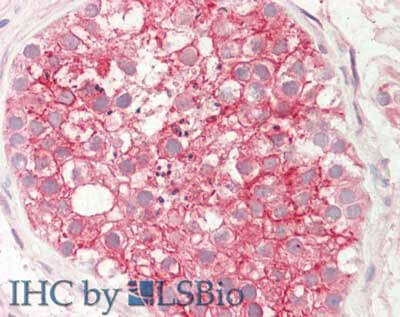Anti-STIM1 (SHEEP) Antibody
STIM1 Antibody
- SPECIFICATION
- CITATIONS
- PROTOCOLS
- BACKGROUND

| Host | Sheep |
|---|---|
| Conjugate | Unconjugated |
| Target Species | Human |
| Reactivity | Human |
| Clonality | Polyclonal |
Application
| WB, IHC, E, I, LCI |
| Application Note | Anti-Stim I antibody is tested for ELISA and immunohistochemistry and suitable for Western Blot. Specific conditions for reactivity should be optimized by the end user. Expect a band approximately ~77kDa corresponding to the appropriate cell lysate or extract. |
| Physical State | Liquid (sterile filtered) |
| Buffer | 0.02 M Potassium Phosphate, 0.15 M Sodium Chloride, pH 7.2 |
| Immunogen | Stim 1 affinity purified antibody was prepared from whole sheep serum produced by repeated immunizations with a synthetic peptide near the N-terminus of human Stim 1. |
| Stabilizer | 50% (v/v) Glycerol with 1 mg/ml Bovine Serum Albumin (BSA) |
| Gene ID | 6786 |
|---|---|
| Other Names | 6786 |
| Purity | Anti-Stim I was affinity purified from monospecific antiserum by immunoaffinity chromatography. A BLAST analysis was used to suggest cross-reactivity with rat, human, and mouse based on 100% sequence homology. Cross-reactivity with Stim I from other sources has not been determined. |
| Storage Condition | Store vial at -20° C prior to opening. Aliquot contents and freeze at -20° C or below for extended storage. Avoid cycles of freezing and thawing. Centrifuge product if not completely clear after standing at room temperature. This product is stable for several weeks at 4° C as an undiluted liquid. Dilute only prior to immediate use. |
| Precautions Note | This product is for research use only and is not intended for therapeutic or diagnostic applications. |
| Name | STIM1 |
|---|---|
| Synonyms | GOK {ECO:0000303|PubMed:9377559} |
| Function | Acts as a Ca(2+) sensor that gates two major inward rectifying Ca(2+) channels at the plasma membrane: Ca(2+) release- activated Ca(2+) (CRAC) channels and arachidonate-regulated Ca(2+)- selective (ARC) channels (PubMed:15866891, PubMed:16005298, PubMed:16208375, PubMed:16537481, PubMed:16733527, PubMed:16766533, PubMed:16807233, PubMed:18854159, PubMed:19182790, PubMed:19249086, PubMed:19622606, PubMed:19706554, PubMed:22464749, PubMed:24069340, PubMed:24351972, PubMed:24591628, PubMed:25326555, PubMed:26322679, PubMed:28219928, PubMed:32415068). Plays a role in mediating store- operated Ca(2+) entry (SOCE), a Ca(2+) influx following depletion of intracellular Ca(2+) stores. Upon Ca(2+) depletion, translocates from the endoplasmic reticulum to the plasma membrane where it activates CRAC channel pore-forming subunits ORA1, ORA2 and ORAI3 to generate sustained and oscillatory Ca(2+) entry (PubMed:16208375, PubMed:16537481, PubMed:32415068). Involved in enamel formation (PubMed:24621671). |
| Cellular Location | Cell membrane; Single-pass type I membrane protein. Endoplasmic reticulum membrane; Single-pass type I membrane protein. Cytoplasm, cytoskeleton. Sarcoplasmic reticulum. Note=Translocates from the endoplasmic reticulum to the cell membrane in response to a depletion of intracellular calcium and is detected at punctae corresponding to junctions between the endoplasmic reticulum and the cell membrane (PubMed:16005298, PubMed:16208375, PubMed:18854159, PubMed:19182790, PubMed:19249086). Associated with the microtubule network at the growing distal tip of microtubules (PubMed:19632184). Colocalizes with ORAI1 at the cell membrane (PubMed:27185316). Colocalizes preferentially with CASQ1 at endoplasmic reticulum in response to a depletion of intracellular calcium (PubMed:27185316) |
| Tissue Location | Ubiquitously expressed in various human primary cells and tumor cell lines. |

Thousands of laboratories across the world have published research that depended on the performance of antibodies from Abcepta to advance their research. Check out links to articles that cite our products in major peer-reviewed journals, organized by research category.
info@abcepta.com, and receive a free "I Love Antibodies" mug.
Provided below are standard protocols that you may find useful for product applications.
Background
Stim I antibody helps regulate calcium influx after the depletion of intracellular calcium stores. It functions as a calcium sensor in the endoplasmic reticulum via its EF-hand domain. After depletion of Ca+2, it is translocated from the endoplasmic reticulum to the plasma membrane so the calcium release-activated channel subunit is activated. Anti-Stim I antibody is ideal for investigators interested in Metabolism and Signal Transduction research.
If you have used an Abcepta product and would like to share how it has performed, please click on the "Submit Review" button and provide the requested information. Our staff will examine and post your review and contact you if needed.
If you have any additional inquiries please email technical services at tech@abcepta.com.













 Foundational characteristics of cancer include proliferation, angiogenesis, migration, evasion of apoptosis, and cellular immortality. Find key markers for these cellular processes and antibodies to detect them.
Foundational characteristics of cancer include proliferation, angiogenesis, migration, evasion of apoptosis, and cellular immortality. Find key markers for these cellular processes and antibodies to detect them. The SUMOplot™ Analysis Program predicts and scores sumoylation sites in your protein. SUMOylation is a post-translational modification involved in various cellular processes, such as nuclear-cytosolic transport, transcriptional regulation, apoptosis, protein stability, response to stress, and progression through the cell cycle.
The SUMOplot™ Analysis Program predicts and scores sumoylation sites in your protein. SUMOylation is a post-translational modification involved in various cellular processes, such as nuclear-cytosolic transport, transcriptional regulation, apoptosis, protein stability, response to stress, and progression through the cell cycle. The Autophagy Receptor Motif Plotter predicts and scores autophagy receptor binding sites in your protein. Identifying proteins connected to this pathway is critical to understanding the role of autophagy in physiological as well as pathological processes such as development, differentiation, neurodegenerative diseases, stress, infection, and cancer.
The Autophagy Receptor Motif Plotter predicts and scores autophagy receptor binding sites in your protein. Identifying proteins connected to this pathway is critical to understanding the role of autophagy in physiological as well as pathological processes such as development, differentiation, neurodegenerative diseases, stress, infection, and cancer.


